Are you winter-ready?
Protecting the wellbeing of home-based workers
Modern office spaces are purpose-designed for productivity. The beneficial impact of appropriate lighting, good air quality and regular breaks are understood and are an integral, yet subconscious part of an office worker’s daily routine.
So, what happens when this ‘regular daily routine’ is interrupted? Whose responsibility is it to support continued productivity? And how can employers and employees work together to create a conducive setting at home?
Sharp NEC, in cooperation with its partner Fusion Spaces, looks at the future of home working wellbeing.
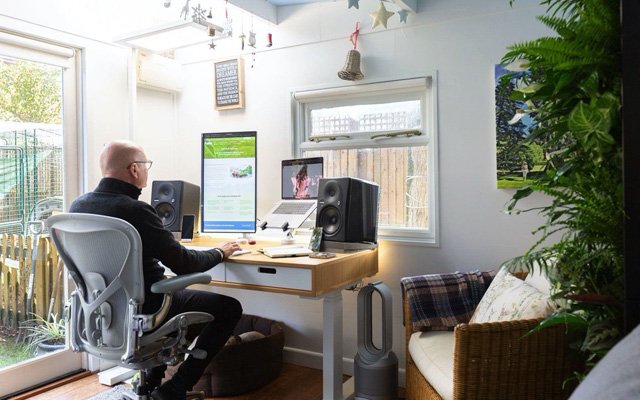
Credit: Cherry Beesley - Simply C Photography
Feel well to work well
First off, it is vital to recognise that productivity and wellbeing go hand in hand. It has always been so, but with the sudden and ongoing disruption to people’s lives, an understanding of human welfare and how it impacts our ability to work has become fundamental to business success.
Fusion Spaces workplace wellbeing and design consultant, Kenneth Freeman, highlights some of the effects of enforced isolation – and they’re not all bad! – in his blog ‘many healthy returns.’
He concludes:
…those organisations willing to invest in creating more humane working cultures will be in the best place to attract and retain eager and talented people.
It is time to rethink what we mean by productivity. Being the first to arrive and the last to leave the office was always a nonsensical measure of productivity, but this was sadly an enduring office culture. Having now proven that you don’t have to be micro-managed to be productive, quite the opposite in fact, now is the perfect time to reshape common misconceptions.
Workplace managers are going to have to consider whole new interactions of disciplines: space, furniture, technology, connectivity, restoration and recuperation, and new approaches to managing people. All will need repackaging to create work environments that people want to use, and we must learn from our experiences over the last few months to create those new working environments.
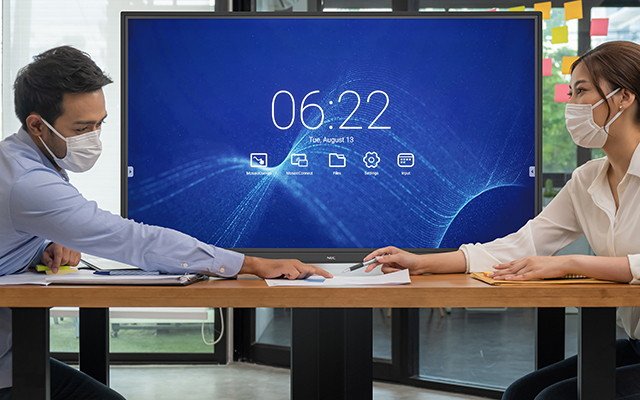
As many workers are tentatively returning to offices, many believe that a hybrid of home working alongside face to face meetings taking place as needed in the office, will be the new working practice.
Preparing workspaces which support this new standard, alongside a more compassionate working culture which prioritises employee wellbeing, should be high on the agenda as businesses plan for the future.
Sharp NEC’s collaboration and meeting room specialist, Simon Hayes, suggests 6 tips for getting meeting rooms prepped for business in his blog, What will meetings look like in 2021?
Preparing for winter
Weather-wise, 2020 has been uncommonly good to us. An exceptional spring and better than average summer at least made lockdown bearable! As we head towards winter however, new challenges arise, with seasonal sadness a scientifically proven condition.
Humans need daylight to thrive; our ancient ancestors lived in harmony with the seasons, changing their work pattern accordingly. Many species in the animal kingdom hibernate in the winter - although we’re not suggesting you just go to sleep for the next 6 months! An appreciation of the physiological effects of seasonal change will help to alleviate associated anxieties and enables us to put measures in place to support wellbeing.
We highlight 7 key areas to consider when creating an environment at home which is conducive to work, particularly as natural light becomes an increasingly scarce resource. Through our partnership with Fusion Spaces, we can offer help, advice and innovative products to help you combat the effects of these issues, find out more here.
1. Get the lighting right
As we head towards winter in this most unprecedented of years, lighting becomes an increasingly important element as daylight hours shorten.
Where the traditional office is ‘lit for purpose’ - designed to support alertness and minimise eyestrain - in the home setting, the ‘purpose’ is quite different.
Lighting is well known to impact our circadian rhythm, or body clock; warmer light temperatures mimic the sun at sunset, it prepares us for rest and sleep. Perfect for the bedroom or living room at the end of the day, not so great if you’ve set up your home office in the corner of these spaces!
There is no better light than natural light, but as the days shorten, we’ll be turning the lights on at home to continue work. What will the quality of this artificial light be? Studies have shown that reliance on artificial light affects our health and wellbeing: decreased motivation, low mood, lethargy and eye fatigue. Understanding this link should place more importance on appropriately lighting the workspace at home. Biodynamic lighting solutions work with your body clock to help you feel energised in the daytime and ready to sleep well at night.
Cooler light temperatures are closer to daylight, a time when your body should naturally be more active, it therefore helps to increase motivation and productivity.
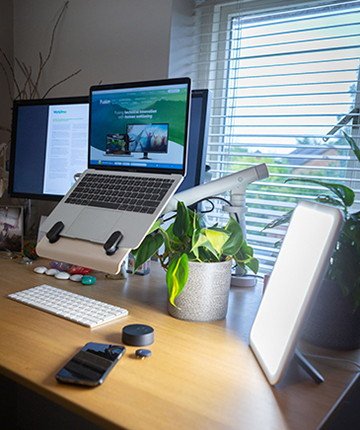
Credit: Cherry Beesley - Simply C Photography
2. Take a daylight break
We’ve touched already on the importance of daylight - a precious commodity which is in increasingly short supply at this time of year. Getting outside for a daylight break should be considered as normal as taking a coffee break, as one would have done in the office without a second thought.

The additional benefit is the opportunity to disconnect for a few minutes, a stretch of your legs and a few deep breaths can be remarkably invigorating, ready to return to your desk, refreshed. Jayne Cox, wellbeing consultant at Fusion Spaces, recommends to aim for regular breaks: “at least 5 minutes per hour; you can use your wearables or set discrete alarms if you’re likely to forget.”
“Light allows us to live - it’s that simple. This makes daylight breaks an essential part of planning to feel calmer over the course of the changing seasons.”
Don’t leave it until the end of the day, it could be dark by 4pm. A brisk early morning walk and a lunch time stroll can be enough to reset body and mind. Those lucky enough to own a dog will also benefit from the satisfaction of knowing you are multi-tasking!
3. Stand, sit, move
Sometimes termed ‘sitting disease’, our sedentary lifestyles can see office workers regularly sitting for 10 hours or more each day.
There is a depressingly long list of risks associated with long periods of inactivity including type 2 diabetes, some cancers and cardiovascular disease. Quite apart from the physical benefits, getting active stimulates your mental wellbeing.
UK Government guidelines recommend at least 150 minutes of moderate intensity activity (such as brisk walking or cycling), or 75 minutes of vigorous intensity activity (such as running), or a combination of both, per week.
We’ve already recognised the benefits of a daylight walk each day so we can pat ourselves on the back for that, and if you can factor in more vigorous exercise, even better!
But even the smallest movements can make a huge difference in getting the blood pumping, feeding your vital organs, including your brain!
Rather than just sitting, get up, stretch, move. For relatively low cost, a standing desk enables workers to move from sitting to standing, raising and lowering with a manual hydraulic lift action. Featuring dual monitors mounted on an arm, by taking your zoom call whilst standing, you will be literally thinking on your feet which is scientifically proven to make us sharper and more attentive.
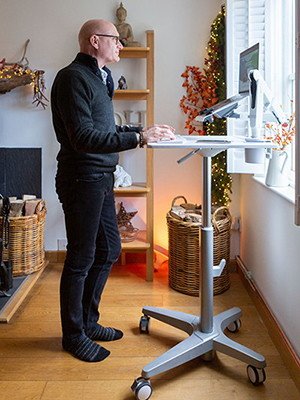
Credit: Cherry Beesley - Simply C Photography
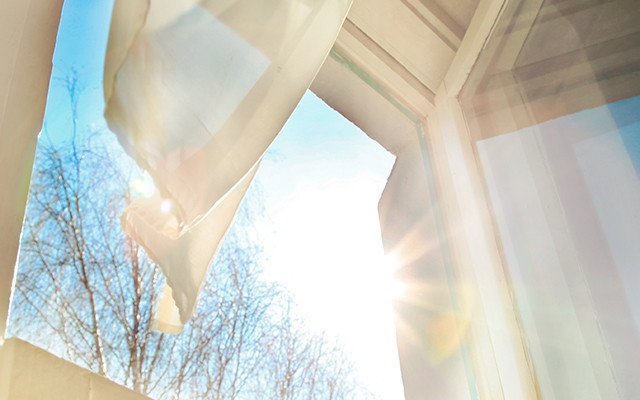
4. Improve the air quality
In a modern office environment, air quality will be carefully monitored and regulated by the facilities manager. Disputes can arise where there is the ability to open a window however - whilst it might be empowering to control your own environment, you’re likely to be sharing the space with others!
Opening a window risks letting pollutants in (as well as a cold draft!) but it’s also an effective way of reducing ‘stuffiness’ and pollutants building up inside the building such as carbon dioxide which can make you feel sleepy. Recent research confirms that elevated levels of carbon dioxide have a significant impact on cognitive ability.
In your home office you have the luxury of deciding for yourself whether to open the window, but as the weather turns colder its likely to remain closed more often than not.
Depending on the size of the space you have claimed for your home office it could quickly become oppressive without you realising that it’s affecting your ability to function effectively, consider using an air purifier to improve the quality of the air naturally and sustainably.
5. Get the temperature right
The onus has always been on corporate organisations to minimise and declare their environmental footprint, now, as the fuel bill reduces in the office, it will increase significantly at home – certainly something to be aware of as the heating clicks in more frequently. Whilst you have saved money and contributed to reducing your carbon footprint by travelling less frequently, keeping your home office at an appropriate temperature will have budget implications too.

By fitting a smart meter (free from your energy supplier) you can track your power usage to keep on top of the costs, you’ll be surprised how they build up when you’re spending more time at home than you used to. There’s no point being uncomfortable however, and whilst an extra layer is sensible, frost bite in your toes is not conducive to productivity.
You may be surprised to note that your gas central heating system probably accounts for at least 50% of your annual energy bill – it could be worth investing in a modern condensing boiler to dramatically reduce your energy consumption.
A brand-new condensing combi boiler is going to be far more efficient than a boiler even just 5 years old. By converting 94% of consumed energy into usable heat, a high efficiency A-rated boiler wastes just 6% of energy, compared to 20-35% wastage from an old inefficient boiler.
A comfortable temperature range might be between 18 and 22 C, but it is entirely down to personal preference. One of the many benefits of working from home is that you have personal control over the thermostat without having to negotiate with colleagues or facilities managers!
6. Bring the outdoors in
This year especially, outdoor spaces have been a lifeline, offering us the chance to leave the confines of the four walls to benefit from our allotted exercise time during lockdown. With our social lives curtailed, a simple work in nature has become enormously pleasurable.
Human beings have an inherent need to connect with nature and green spaces. Biophilic design has long been a key concept in modern office interiors, recognising the psychological benefits of bringing natural elements indoors.
Research published in 2014 by the “Journal of Experimental Psychology: Applied” found that the presence of plants inside a building increases the occupants’ feelings of wellbeing by 40 percent; adding biophilic elements to offices can increase productivity and reduce absenteeism.
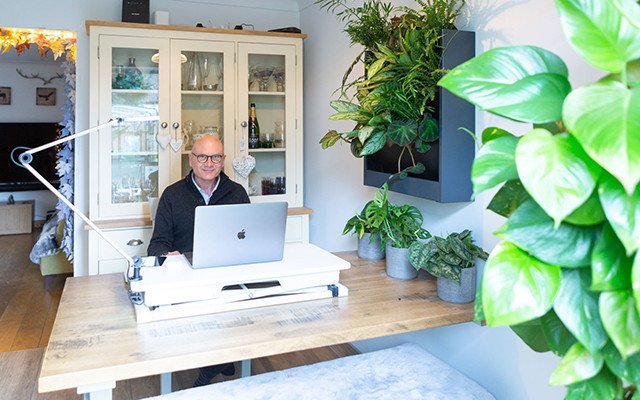
Credit: Cherry Beesley - Simply C Photography
From a few simple pot plants to dramatic living walls and glass domed green houses, the extent to which organisations have invested in this trend has been varied - let’s hope someone is tasked with keeping them watered whilst many buildings are largely unoccupied!
With less opportunity to get outdoors in the winter months, surrounding ourselves with some natural elements indoors can keep us connected with nature, perhaps we can bring a few biophilic elements of our own into our home office environments.
7. Avoid video conferencing fatigue
Connecting remotely with colleagues and customers is likely to continue to be a key feature in our working day. Many have already noticed how intense it can be compared to face to face meetings, even just an hour-long conference call can be tiring making the need to take regular breaks all the more important.
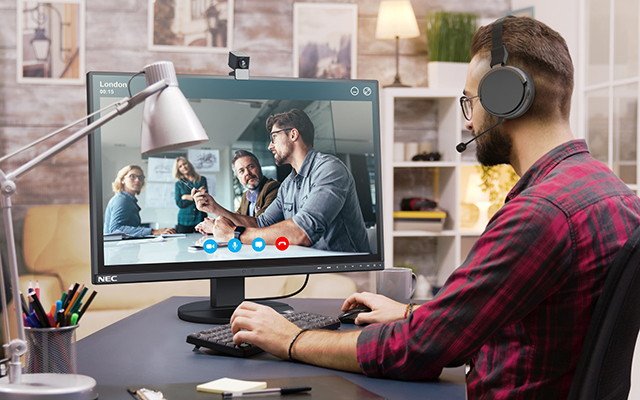
It’s not always possible to schedule your call for daylight hours, especially if you’re connecting with people overseas, but natural light is always best to work by where possible. Artificial light can be tricky to get right for video conferencing where task lighting can cause reflections and unflattering shadows.
Staring at a screen in unnatural light is fatiguing, Jayne Cox suggests ‘taking breaks for your eyes to avoid eyestrain, headaches and general tiredness. Try looking at the horizon for a few minutes and closing your eyes and complete some slow and complete blinks.’
Ergonomically designed screens such as NEC’s desktop display ranges incorporate low blue light technology to protect against macular degeneration. Flicker-free technology and built-in ambient light sensors combine to ensure the best possible viewing experience to support user wellbeing.
Are we ready to embrace a whole new working style?
Working away from the office, and its prescriptive office hours, should release us from following a standard work pattern. We should respect the wisdom of our ancestors and start early and finish early, to be more in tune with our circadian rhythm.
We can achieve the same number of productive hours, we simply give ourselves a little flexibility. By being kinder to ourselves, cutting ourselves a little slack, we can relieve the tension and gain all the benefits that working from home always promised us.
We have entered this new workstyle in very dramatic fashion, however. Whilst many organisations sign up to employee wellbeing standards for traditional office-based working practices, there is little provision for different management styles and the level of trust and empowerment given to staff. Are organisations ready to allow greater autonomy to their workforce in how they manage their working day?
In a new whitepaper, Kenneth Freeman puts forward the need for a new assessment method, one which acknowledges that working practices will differ significantly between working in the office (which is well regulated) and working from home (with widely different set-ups and additional psychological considerations).
He says: ‘Responsible employers should consider whether they are ensuring that their home-based workers are in healthy, safe, engaged environments, and whether they are complying with best practices as well as the law’.
‘Away from the office: how to create new working environments that are happy, healthy and effective’
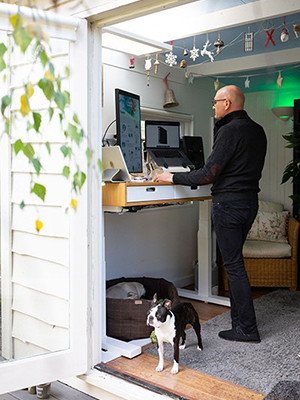
Credit: Cherry Beesley - Simply C Photography
Use the WorkFree™ online assessment tool
Temporary guidance for home working is no longer appropriate. Remote working is now a normal occurrence and employers must ensure that they can provide legally compliant working environments. With a more compassionate perspective on productivity, new guidelines to support home workers will lead to better outcomes for organizations.
WorkFree™ is a new assessment method for managing the health, wellbeing, safety and engagement of home-based workers. It is based on three equally important foundations, which will enable employers and employees to achieve the mutually beneficial goal of healthy, happy and effective work.
- Assurance. To enable employers to meet their responsibilities and obligations to ensure that employees have a safe place to work. This includes having systems to manage compliance with legal requirements, and the need to provide the necessary evidence for compliance and benchmarks for continuous improvement.
- Comfort and quality. To ensure that home-based workers can set up an effective and comfortable working environment that suits them, and which gives access to a range of professional quality (but domestic scale) products to support and improve their physical and mental health and wellbeing.
- Freedom and empowerment. To ensure that home-based workers are empowered to manage their work and space. Employers must respect boundaries of privacy, minimise intrusion into the private space of their employees (physically and digitally), and recognise and respect different domestic and family arrangements without judgement.

